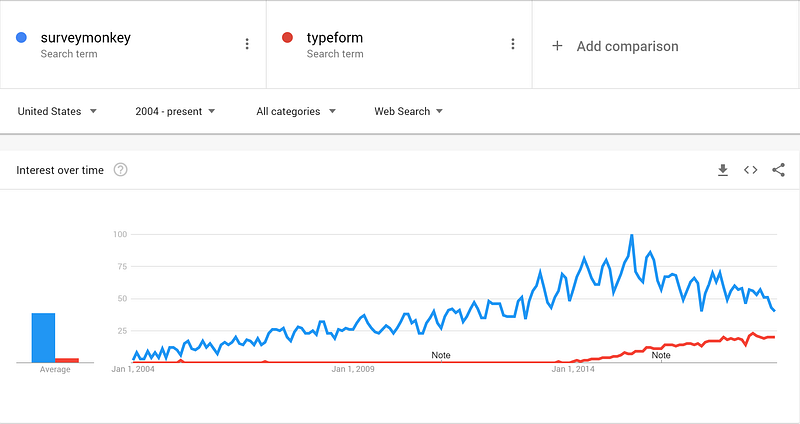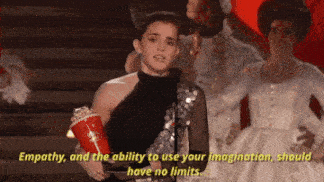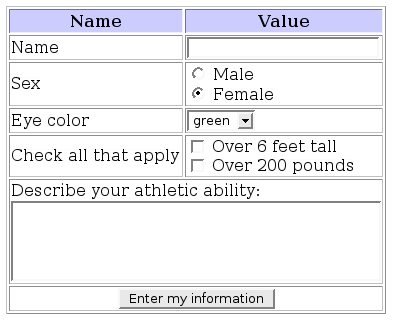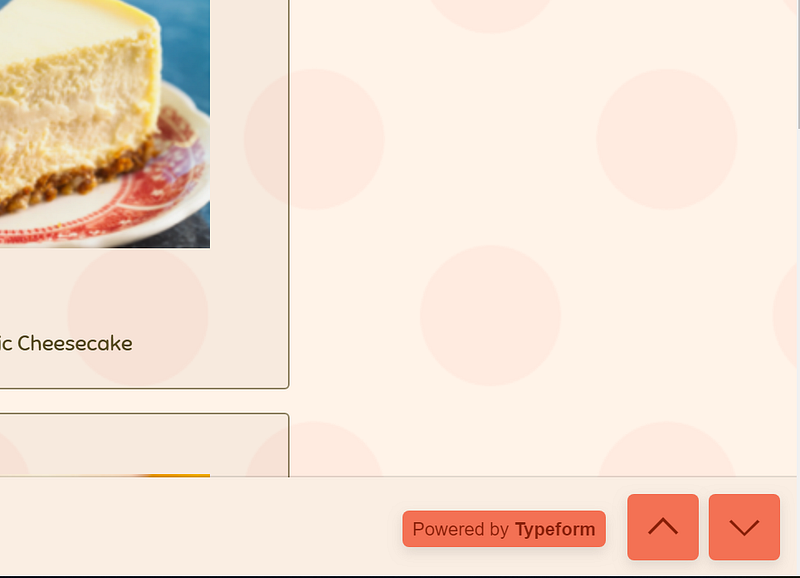Typeform: Transformando formulários em conversas humanas
Produtos Icônicos Episódio 009
Antes de começarmos, um aviso: eu uso o Typeform e o adoro. 😍

Estamos usando o Typeform há algum tempo na Salesflare e eu não gostaria de usar nenhum outro software de pesquisa com nossos clientes.
Adoro o fato de a experiência ser muito melhor do que com qualquer aplicativo concorrente. O uso do Typeform torna a interação com o Salesflare um pouco mais humana, o que é algo que valorizamos muito. ❤️
O Typeform torna o relacionamento com nossos clientes mais humano.
Apesar de tudo isso, nunca consegui determinar concretamente como eles fazem isso. Por que nenhum outro aplicativo parece se comparar. E como o Typeform está mantendo essa vantagem durante todos esses anos. Por que ninguém os supera?
Por isso, embarquei em nossa nona missão de Produtos Icônicos, investigando o que exatamente torna o Typeform tão icônico.
Vamos lá 👇
Tornando as coisas um pouco mais humanas
A faísca para o Typeform surgiu quando os fundadores estavam criando um formulário de lead que seria usado em um espaço de exposição. Você sabe, essas coisas que capturam seus dados.
Eles queriam torná-lo melhor do que o que já tinham visto antes. Em vez de apenas criar um formulário padrão, eles queriam criar algo que realmente chamasse a atenção das pessoas e as envolvesse.
Eles detectaram uma falta de empatia na forma como a maioria das empresas estava solicitando dados. Passar de conversas face a face para formulários on-line parecia um passo muito grande. As pessoas ainda estavam escrevendo em caixas e clicando em pequenos botões, o que não parecia ser uma experiência muito humana. 🙄
Inspirados pelo filme "Jogos de Guerra", em que o personagem principal tem uma conversa digitada com um computador mainframe, eles imaginaram que poderiam criar um formulário que se parecesse mais com uma conversa.
 A inspiração para o Typeform: Jogos de Guerra. Está vendo ou não? 😏
A inspiração para o Typeform: Jogos de Guerra. Está vendo ou não? 😏Eles se propuseram a criar algo mais agradável do que preencher algumas caixas. Eles queriam remover a barreira entre humanos e computadores.
Anos depois, eles resumiram isso na declaração de visão da Typeform:
Tornar as coisas um pouco mais humanas ✨.
A Typeform acredita que os formulários não servem apenas para coletar os dados de que você precisa, mas também para controlar a impressão que você deixa. Ou, como eles costumam dizer: "A forma como você pergunta é tudo". 🤯
Typeform coloca a experiência humana acima dos dados
O DNA de uma empresa geralmente começa com seus fundadores.
No caso da Typeform, a maneira favorita dos co-fundadores de passar o dia é projetando. É quando a energia deles realmente flui. 🤩
Seu maior concorrente e líder de mercado, SurveyMonkey, é, por DNA, uma empresa de análise de dados. A Typeform é diferente. É uma empresa de interface de usuário.

É claro que a equipe se preocupa com os dados. Caso contrário, eles não estariam criando um software que coleta dados. Mas eles têm uma mentalidade de "primeiro as pessoas, depois os dados".
Eles acreditam em ser "informados por dados, em vez de orientados por dados". Isso significa que eles reconhecem o poder dos dados, mas também nunca deixarão de lado suas intuições.
É uma questão de combinar a percepção do cliente com as taxas de conversão. Equilibrar sentimentos e fatos. Sentimentos e métricas.
A Typeform coloca o design empático acima do design orientado por dados.

A equipe da Typeform às vezes diz que trabalha com HX, não com UX. Experiência humana, não experiência do usuário.
A experiência do usuário consiste em levar uma pessoa de A a B com sucesso. A HX vai além disso. Ela faz a seguinte pergunta: eles chegaram ao ponto B com uma conexão emocional?
A equipe da Typeform pensa em seres humanos. Pessoas reais. Quais são suas necessidades? Suas emoções?
Isso requer pensar em quem o usuário realmente é. Aproximar-se dele. Entendê-lo. 🤗
Para isso, a Typeform faz muitas pesquisas com os clientes. E não é apenas a equipe de produtos que testa constantemente novas ideias com os clientes. A equipe go-to-market também está trabalhando para tentar se aproximar dos clientes, para entender onde realmente está o valor para a Typeform, o que eles realmente querem.
No final, a conexão emocional é o que faz com que as pessoas se apaixonem por um produto. ❤️
O design do Typeform é o resultado de um foco incansável
Parece que esses caras da Typeform são gênios, não é?
Embora parte do sucesso do software possa ser atribuída à inteligência e às escolhas inteligentes, provavelmente é mais o resultado de um foco extremo. É o investimento incessante de tempo e recursos em um objetivo claro.
O que você vê hoje quando preenche um Typeform é o resultado da obsessão por centenas de pequenos detalhes durante um longo período de tempo. A equipe trabalhou incansavelmente em várias iterações, cuidando das menores partes da interação do formulário, uma a uma.

Ao se concentrar constantemente na usabilidade, no toque humano e no belo design, a Typeform reinventou algo que já existia há décadas. E eles continuaram aperfeiçoando e expandindo-o continuamente para manter sua exclusividade.
E isso serviu muito bem à Typeform. Em um mercado saturado como o de software de formulários, competir copiando o que já existe teria sido infrutífero. Em vez disso, a Typeform produziu algo que as pessoas queriam e ainda não estavam obtendo: uma bela maneira de criar formulários envolventes.
Eles nos fornecem formulários que não parecem ser formulários
Coloque sua mão no ar se você gosta de preencher formulários...
Sim, acho que não. 😏
Todos nós precisamos nos comunicar sobre dados, mas não gostamos de formulários. Queremos formulários que não pareçam formulários.

Veja como tornar os formulários mais humanos.
Um de cada vez
O Typeform divide a interface do formulário em componentes menores. Você não vê uma grande lista de perguntas, mas apenas uma de cada vez e, assim, há um fluxo natural de informações.

Isso o torna mais gerenciável, mais motivador e mantém as pessoas mais engajadas.
Fontes maiores para conversas mais humanas
Uma pergunta de cada vez significa que há mais espaço na tela que pode ser usado.
E, ao usar fontes muito maiores do que a média dos formulários, os criadores de formulários também são incentivados a criar perguntas mais diretas e mais humanas. E as pessoas que o preenchem dão respostas mais humanas.
Sem caixas, menos botões
Escrever em caixas e clicar em pequenos botões não parece muito humano. É por isso que o Typeform trabalha com uma linha de texto e um cursor. Uma pergunta e uma possibilidade de resposta. É isso aí.

Gosta mesmo de botões? Eles mostrarão isso. Mas se não quiser tocar no mouse e usar apenas o teclado, isso é totalmente possível. Basta pressionar "enter" ou uma das teclas de atalho indicadas ao lado da resposta.
Além do texto
Um formulário comum é uma folha de texto grande, solicitando mais texto.
O Typeform permite que você crie facilmente formulários com ícones, imagens, gifs e vídeos. Isso torna as coisas mais visuais. E, mais uma vez, mais humano.

Typeform cresce por meio de viralidade e integrações
Como todos os produtos que crescem na velocidade da luz, seus mecanismos de crescimento são especiais e inerentes ao uso principal do produto.
1. Crescimento viral: cada formulário enviado é um anúncio para o Typeform
As pessoas enviam formulários às pessoas. Esses formulários são bonitos. E eles contêm uma sutil menção "Powered by Typeform".

Simples assim, mas esse botão corresponde a 50% das inscrições do Typeform. 🚀
2. Integrações: as pessoas permanecem se o Typeform fizer parte de um fluxo de trabalho
As integrações são ótimas para a retenção do Typeform. Se você enviar uma pesquisa apenas uma vez, talvez não precise do Typeform depois disso. E você pode acabar interrompendo sua assinatura. 🛑
Assim que você incorpora formulários em um fluxo de trabalho, tudo isso muda. Você não pode simplesmente parar de usar o Typeform. Isso exigiria a substituição do formulário ou até mesmo a interrupção de todo o fluxo.
É por isso que o Typeform dedicou muito tempo à criação de suas integrações com o MailChimp, o Google Sheets, o Zapier, ... e permite que você incorpore formulários em qualquer site.

3. Branding: as pessoas só escolhem o Typeform se acharem que ele é diferente
A equipe da Typeform gastou uma quantidade enorme de tempo e recursos para entender e redefinir sua marca. E depois refizemos todos os designs.

Eles querem garantir que as pessoas entendam o lado humano da empresa e como eles tornam os formulários mais humanos. Dessa forma, eles querem ir além de ser apenas uma empresa de software. 🦄
E eles também querem começar a se comunicar claramente sobre o outro aspecto que o Typeform quer superar: ser apenas sobre formulários.
O Typeform pretende ir além dos formulários
Desde o início, os fundadores da Typeform tiveram uma visão que visava tornar a comunicação mais humana.
Eles começaram com formulários e se chamaram Typeform. Agora eles querem ir além disso.
Eles estão tentando deixar de ser vistos como uma ferramenta de formulário ou um construtor de pesquisas e passar a ser percebidos como uma ferramenta de comunicação. Em direção a uma comunicação humana em geral.
No momento, você pode usar o Typeform para organizar pesquisas, formulários de feedback, quizzes, histórias interativas, ... mas o objetivo é muito maior. 🔭

O Typeform permite que você tenha uma conversa por meio de uma interface. Você pode fornecer dados e conectar dados com o Typeform. Você pode criar fluxos de trabalho.
As pessoas sempre terão que coletar informações de outras pessoas. A questão é como elas farão isso. Nem sempre isso acontecerá por meio de um navegador ou de um formulário. Entre outras coisas, a equipe já está pensando em usar IA, VR e tecnologia de voz. Organizar e transcrever automaticamente as conversas.
A Typeform tem como objetivo criar interfaces de conversação e descobrir como elas substituirão as interfaces tradicionais de apontar e clicar.
E eles não vão parar até atingirem seu potencial máximo. 🙌
Bônus: Typeform... o que há no nome?
Você já se perguntou qual é o significado do nome Typeform? 😏

De acordo com seu cofundador, David Okuniev, refere-se a:
- A capacidade de simplesmente digitar o formulário sem tocar no mouse
- O fato de ser um tipo diferente de formulário
- A importância da tipografia em seu produto
Deseja conferir mais produtos icônicos? Leia a série completa aqui! 📲
Esperamos que você tenha gostado desta postagem. Se gostou, espalhe a notícia!
Para obter mais informações importantes sobre startups, marketing de crescimento e vendas:
Última atualização:
- 7 melhores CRMs para Mac em 2025 - setembro 19, 2025
- 7 melhores alternativas de CRM da HubSpot em 2025 - setembro 17, 2025
- 7 melhores alternativas ao Pipedrive em 2025 - setembro 16, 2025